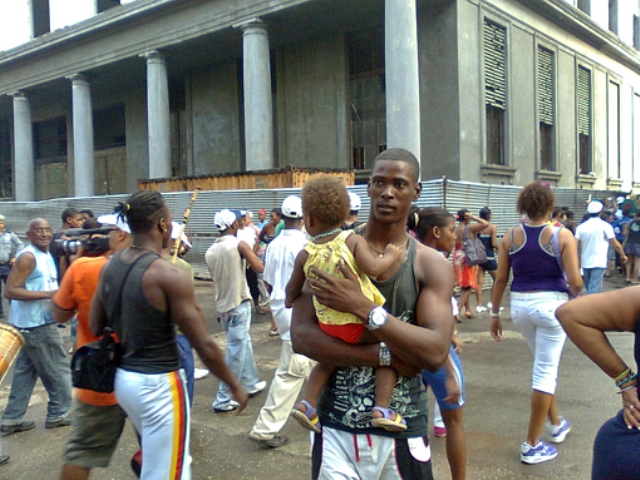Anonymous Afro-Cubans Heroes Remembered for Posterity
Patricia Grogg

HAVANA TIMES, Dec 21 (IPS) — Under the spreading shade of a wild fig tree in Old Havana, a small plaque now recalls the sacrifice made by five Afro-Cubans, “anonymous Abakuá who died trying to save medical students” shot by firing squad, when this island was still a Spanish colony.
The anonymous heroes belonged to a secret society called Abakuá, a religious brotherhood brought to Cuba by slaves from West Africa that has been misrepresented and discriminated against in Cuba for over a century.
National history books provide abundant accounts of the Nov. 27, 1871 summary execution of eight medical students, on the unsubstantiated charge of desecrating a Spanish military officer’s grave. Every year, Cuban students march to the monument that honors these young men, who died swearing they were innocent.
But the deaths of the five Abakuá who died protesting their execution have been ignored by official histories, complained Tato Quiñones, the coordinator of the Nov. 27 ceremony organized since 2006 by the Haydée Santamaría Critical Thought and Emerging Cultures Collective and the Cofradía de la Negritud, an association of black people aimed at raising awareness of discrimination.
The two forums are associated with the Critical Observatory, a civil society network.
“Thirteen young men, black and white, died that day,” Quiñones told IPS. “Therefore we also took time to visit the university students’ monument (as well as the plaque commemorating the five Abakuá), to honor all the victims.
“The tribute is a modest one, a matter of setting the historical record straight, because (the memorials) are still segregated,” he said.
On rare occasions, the oblivion to which the Abakuá were consigned was lifted, Quiñones said. Granma, the official newspaper, published an article in 2009 on the historic episode, and in 1961 Argentine-Cuban guerrilla leader Ernesto “Che” Guevara (1928-1967) said at the annual commemorative ceremony that “the students who were shot that day were not the only ones to shed their blood.”
Guevara said, “The records mention in passing, as a trivial detail that still goes unnoticed in our day, that the corpses of five Negroes were found, and that they had been shot and stabbed to death with bayonets.” He cited eyewitness testimony that Spaniards, too, had been injured in the melée.
In the view of Quiñones and other experts, history will be made whole only when a single ceremony can be held to pay tribute jointly to the medical students and the five young black men. Anthropologist María Ileana Faguada told IPS, “This is why it was important for us also to have visited the students’ memorial.”
The plaque was put up on Nov. 27 this year in a ceremony that included poems, songs, dances and drumming. Dozens of Havana residents took part, before walking to the nearby monument commemorating the students shot by firing squad in 1871.
Some 250 people joined the procession, including Abakuá members from different parts of Havana, intellectuals, and well-informed local people. The parade was led by two “iremes” — small devils representing the spirits of the ancestors — who danced to the music of an Abakuá “coro de clave” (rhythm chorus).
“These five Abakuá were an example of the indomitable Cuban character. They sacrificed their lives in an attempt to save the students, even though they knew they could not succeed. It goes to show that even in those days, there were Black Cuban people with such a strong sense of identity and humanity that they were willing to die for it,” Faguada said.
According to Esteban Morales, a race studies scholar, the reason the five Abakuá were largely forgotten may be the historical prejudices against religions of African origin and their practitioners, in spite of the fact that many who fought for Cuba’s independence were black practitioners of these religions.
The Abakuá brotherhood was brought to Cuba by slaves taken from the West African region of Calabar, between the east bank of the Niger River and what is now Cameroon. Only men are admitted, and the mysteries underlying its beliefs are still shrouded in secrecy.
According to Quiñones, the Abakuá society was first recorded in 1906, in the book “Los Negros Brujos” (Black Witchcraft) by Fernando Ortiz, an ethno-anthropologist renowned as one of the discoverers of the African roots of Cuban culture.
The brotherhood is, among other things, a mutual aid society. Its members adhere to a strict code of values, Orlando Gutierrez, a doctor who advocates a general recognition of the role of the five Abakuá in the historical event, told IPS.
He said an Abakuá priest allowed white men into the society for the first time in 1863, making it the first “integrationist” organization in Cuba.
“There was brotherhood between blacks and whites. It is said that one of the students facing the firing squad may have been an Abakuá society member,” Gutierrez said.
Among the Abakuá, the events of Nov. 27, 1871 have been passed down in oral history as part of a treasured legacy of rebellion. “We want this commemoration to be an act of emancipation, vindication and historical justice,” Quiñones said.
